Condition

9x18mm Ultra: The Overlooked German Cartridge
The 9x18mm Ultra—later also known as 9x18mm Police—may not be as famous as 9×19mm Luger or as widely produced as .380 ACP, but this unique round has a storied past that deserves greater recognition. Conceived in 1936 for Germany’s wartime Luftwaffe and revived decades later in the 1970s, it embodied an ambitious goal: to sit snugly between .380 ACP and 9mm Luger while retaining manageable recoil. Below, we’ll delve into the 9x18mm Ultra’s remarkable development, its technical merits, and the curious case of the Walther PP Super—one of the few pistols that dared to champion this intriguing cartridge.
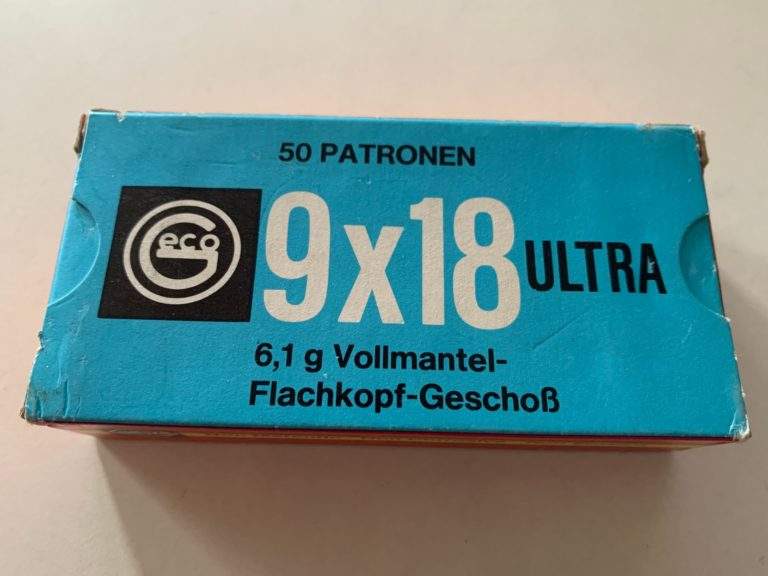

A box of 50 rounds of 9x18mm Ultra – Images via the Cartridge Collectors.org forum
Table of Contents
Origins: 1936 and the Luftwaffe’s Unofficial Dream
The 9x18mm Ultra was originally conceptualized in 1936 for Nazi Germany’s Luftwaffe (Air Force). The impetus was simple: design a pistol cartridge with more power than the then-common 7.65mm Browning but less recoil and muzzle blast than 9×19mm Parabellum. While promising in theory, it never saw official adoption by the Luftwaffe.
Early Abandonment
Why wasn’t it embraced during WWII? Some historians suggest that the rapid expansion of Germany’s arms needs overshadowed specialized mid-range pistol rounds. As the war dragged on, manufacturing efforts concentrated on well-known designs like 9mm Luger and 7.92×57mm Mauser. This left the Ultra concept as an intriguing, half-realized footnote, destined to remain dormant until the political landscape and policing needs of the 1970s revived it.
A Brief Note About Names & Dimensions
The early 9x18mm Ultra was a straight walled cartridge and as best I can gather, didn’t make it much farther the fleeting Luftwaffe interest.
The 9x18mm Ultra that we’ll be talking about today is a tapered case with a slightly larger case bottom than at the top.
Muddying the waters even further is the 9x17mm Ultra that was briefly produced from 69′ to 71′ according to American Rifleman.
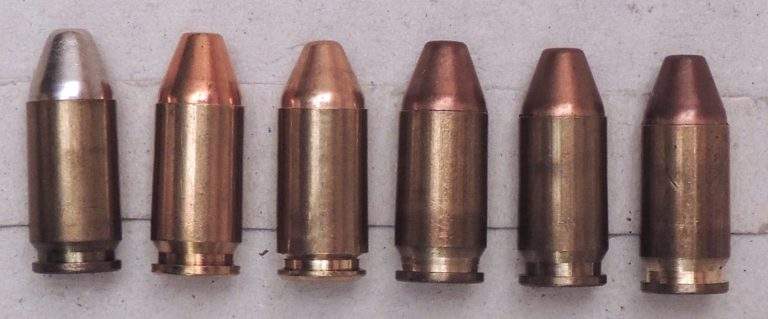

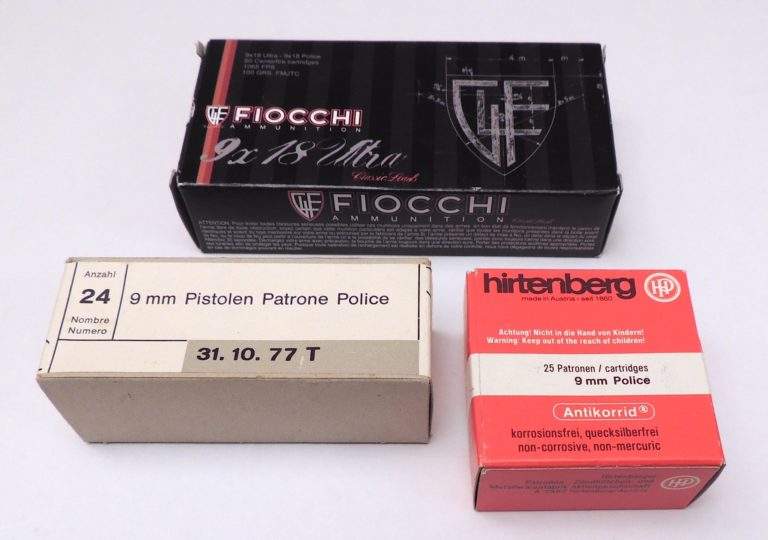
Various cartridges and boxes of ammunition of the 9x18mm Ultra or 9x18mm Police cartridge. Images via the Cartridge Collectors.org forum
Mid-Century Fade & 1970s Revival: 9x18mm Police
By the late 1960s and early 1970s, West German police agencies began rethinking their sidearm requirements, especially amid rising crime rates and terrorist threats. Much of the force carried .32 ACP or .380 ACP pistols, which many found underpowered. On the flip side, 9mm Luger was deemed too strong for blowback designs and, in some administrative eyes, excessive for routine police duties. Enter the 9x18mm Ultra, newly rebranded as 9x18mm Police—two names for the same cartridge.
Pictured is an article from American Rifleman – circa 1978 describing the evolution of the 9x18mm Ultra and another short lived “9x17mm Ultra”.

The German Police Experiment
Gun makers like Walther, SIG Sauer, Mauser, and Benelli saw an opening to develop pistols chambered for the revived round. Ammunition manufacturers such as Geco (Dynamit Nobel), Hirtenberger, and Fiocchi stepped in to offer factory loads. The concept was straightforward: provide a blowback-friendly cartridge with a performance edge over .380 ACP yet with less recoil than a 9mm Luger.
Short-Lived Excitement:
Despite initial enthusiasm, the eventual outcome was lukewarm. The unstoppable momentum of 9×19mm Parabellum overshadowed any attempt at establishing 9x18mm Police as the new standard. By the late 1970s, most police forces solidified their choice of standard 9mm Luger service pistols, leaving the 9x18mm Ultra to fade from official use once again.
The 9x18mm Ultra could have possibly found a place as a stronger .380, but in a “mouse gun” this runs into some issues.
Walther PP Super: A Brief but Bold Statement
Among the few firearms that dared to adopt the 9x18mm Ultra was the Walther PP Super. Released around 1972–1973, it represented Walther’s modern attempt to offer a police pistol bridging .380 ACP and 9mm Luger. Built on the proven Walther PP lineage, the PP Super stood out for its:
- All-Steel Frame: A robust construction, allowing it to handle higher pressures than typical .380 blowback pistols.
- Enhanced Safety: Features like a decocking lever instead of a manual safety and an automatic firing pin safety were designed to meet new police standards.
- Ergonomic Refinements: Slight modifications to the classic PP design aimed at improved recoil management with a hotter round.
Walther’s optimism for the PP Super was evident: they believed the 9x18mm Ultra cartridge, matched with a blowback pistol, struck the perfect balance. However, police departments quickly pivoted to 9×19mm service pistols, dooming Walther’s hopes. Production of the PP Super ended in 1979 after only modest adoption (around 2,000 units by certain estimates). Today, collectors treasure the PP Super’s rarity and unique chambering. At the time of this writing there’s examples asking for north of $2k. Additional examples with walnut grips can be seen below.
Beyond the PP Super, additional handguns chambered the 9x18mm Ultra, the Sig P230, the Hauser HSC-80, and the Benelli B76 all had models with the 9x18mm Ultra.
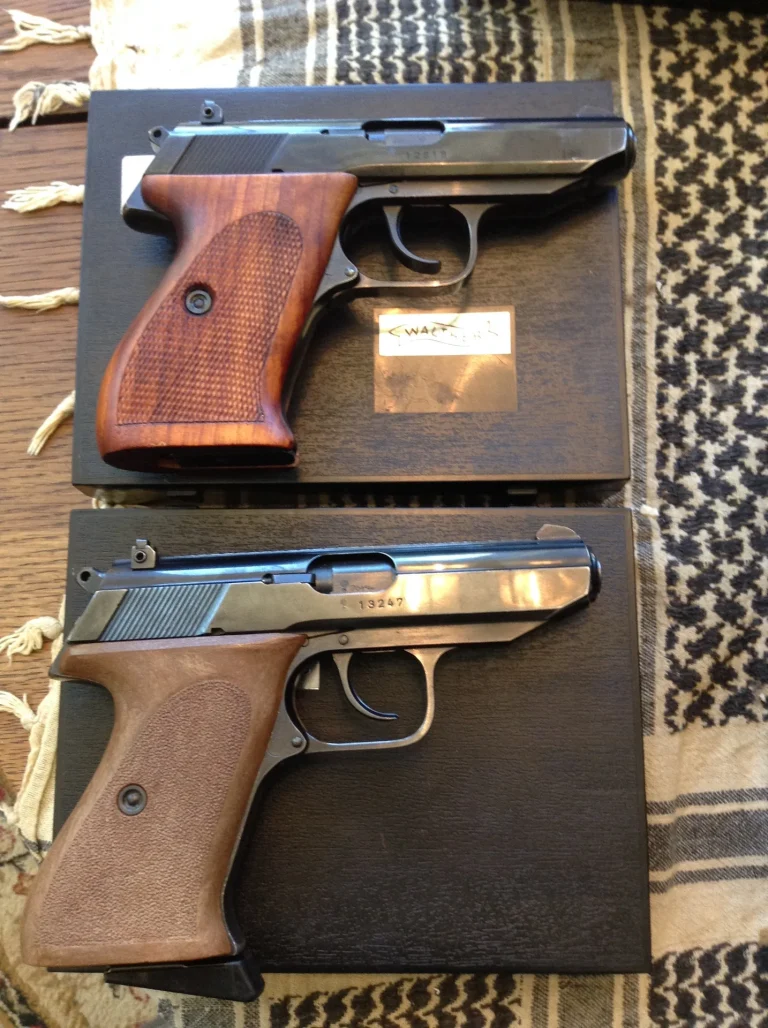
Image via Walther Forums – User farmerdave111
Technical Specs and Performance
While it never challenged the big players, the 9x18mm Ultra carved out a specialized niche. It’s commonly described as a:
“Hotter than .380 ACP, but well below 9×19mm Parabellum.”
Below is a snapshot of its ballistic metrics (as gleaned from original data and factory loads):
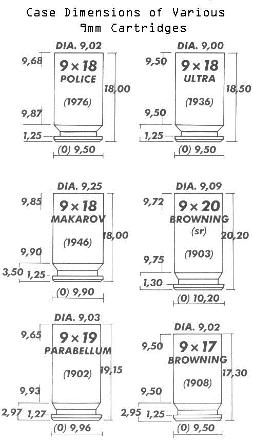
The above image shows various dimensions of the 9x18mm Ultra in 1936 and from its revival in1976. Note that a slight taper to the case was introduced with the modern “police” variation. Image from Brass Catcher.com
| Specification | 9x18mm Ultra / Police |
|---|
| Bullet Diameter | 9.01 mm (0.355 in) |
| Case Length | 17.85 mm (0.703 in) |
| Overall Length | ~25.27 mm (0.995 in) |
| Typical Bullet Weights | 94–100 gr JFP/FMJ |
| Muzzle Velocity | ~320–323 m/s (1,000–1,060 ft/s) |
| Muzzle Energy | ~312–338 J (230–249 ft⋅lbf) |
Pressure typically hovers around the upper end of blowback-design feasibility—more than .380 ACP but nowhere near a +P 9mm Luger. It is possible to convert a 380 ACP pistol to use the 9x18mm Ultra/Police. However, as Brass Fetcher.com notes, it’s a more powerful round and care should be used to select a pistol that will withstand the higher forces. Additionally, some 380 extractors might not play nice with 9x18mm Ultra brass.
Comparisons to .380 ACP, 9×19mm, and 9×18mm Makarov
.380 ACP (9×17mm)
- Ballistics: The 9x18mm Ultra can push a bullet at roughly 20–40% higher muzzle energy than standard .380 ACP loads.
- Purpose: Both were seen as suitable for blowback pistols, although the Ultra’s recoil and muzzle blast were incrementally higher.
9×19mm Parabellum
- Ballistics: 9×19 outperforms the Ultra by a considerable margin, often reaching 350–500 ft⋅lbf of energy.
- Adoption: Due to NATO standardization and widespread acceptance, 9×19 overshadowed any attempt to mainstream a lesser-known 9×18 round.
9×18mm Makarov
- History: Many historians see the Ultra’s original 1936 blueprint as influencing the Soviet 9×18 Makarov.
- Bullet Diameter: Makarov’s .365-inch bullet vs. Ultra’s .355-inch ensures the two rounds are not interchangeable.
- Popularity: The Makarov soared within Warsaw Pact forces. The Ultra, however, remained an outsider.
Below you can see some velocity and kinetic energy comparisons produced by Brass Fetcher.com
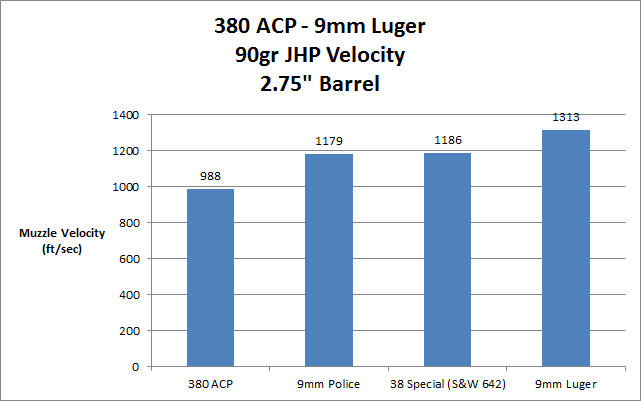
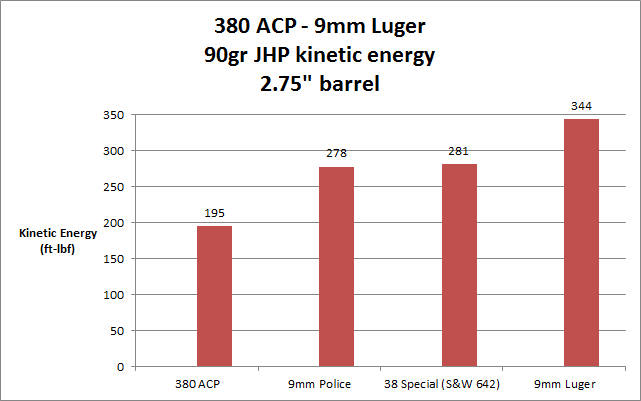
Why It Never Caught On
Despite its respectable ballistic profile, the 9x18mm Ultra faced numerous hurdles:
Shifting Police Preferences
The turbulence of 1970s Europe—particularly Germany—drove police to adopt heavier firepower (full 9×19mm) in response to terrorist threats. The once “perfect” middle ground lost viability quickly.
Entrenched Competition
.380 ACP had decades of popularity across civilian and law-enforcement circles. 9×19mm was already the gold standard for militaries and many police agencies. That left little room for a new commercial middle cartridge.
Limited Pistol Options
While the Walther PP Super led the charge, and SIG Sauer P230, Mauser HSc-80, and Benelli B76 hopped aboard, production runs were modest. Without large-scale adoption or broad marketing, the 9×18 Ultra lacked the momentum needed to thrive.


An “Action” bullet cutaway of 9x18mm Ultra. The plug in the hollow point is intended to help with expansion. Similar design ideas can be seen on the Hornady Critical Defense and Critical Duty Lines that use the FlexLock bullets.
Civilian Indifference
At least in the us civilians could purchase 9x18mm Police loads from Fiocchi, Geco, or Hirtenberger. Today there’s more, but with ammunition being neither widely stocked nor inexpensive, the casual buyer stuck with familiar .380 or 9×19 pistols.
Lingering Legacy & References
Though overshadowed, the 9x18mm Ultra stands as a fascinating piece of firearm engineering—a half-step approach that never quite realized its potential.
Collectors remain interested in both the rare ammunition runs and pistols like the Walther PP Super, which embody that era’s quest for an “ideal” police sidearm. Contemporary makers are for the moment still supplying rounds in this caliber, but that may fade with time.
Final Takeaway - Policing the Brass
While it never dethroned established standards, the 9x18mm Ultra showcases German ingenuity and the complexities of meeting law enforcement’s shifting requirements. Understanding its story underscores how a cartridge’s success hinges on timing, marketing, and institutional endorsement—sometimes, even the best-engineered rounds can slip into obscurity if the market conditions aren’t right.




